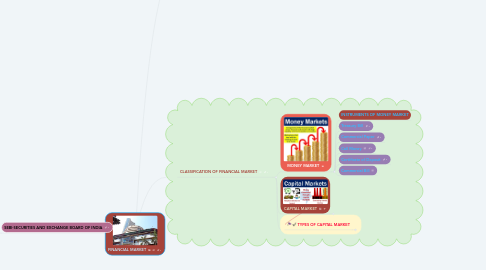
1. SEBI-SECURITIES AND EXCHANGE BOARD OF INDIA
1.1. FUNCTIONS
1.2. REGULATORY
1.2.1. 1. Registration of brokers and subbrokers and other players in the market. 2. Registration of collective investment schemes and Mutual Funds. 3. Regulation of stock brokers, portfolio exchanges, underwriters and merchant bankers and the business in stock exchanges and any other securities market. 4. Regulation of takeover bids by companies. 5.Calling for information by undertaking inspection, conducting enquiries and audits of stock exchanges and intermediaries. 6. Levying fee or other charges for carrying out the purposes of the Act. 7.Performing and exercising such power under Securities Contracts (Regulation) Act 1956, as may be delegated by the Government of India.
1.3. DEVELOPMENTAL
1.3.1. 1.Training of intermediaries of the securities market. 2.Conducting research and publishing information useful to all market participants. 3.Undertaking measures to develop the capital markets by adapting a flexible approach.
1.4. PROTECTIVE
1.4.1. 1.Prohibition of fraudulent and unfair trade practices like making misleading statements, manipulations, price rigging etc. 2.Controlling insider trading and imposing penalties for such practices. 3.Undertaking steps for investor protection. 4.Promotion of fair practices and code of conduct in securities market.
2. FUNCTIONS OF FINANCIAL MARKET
2.1. 1. Mobilisation of Savings and Channeling them into the most Productive Uses
2.1.1. 2. Facilitating Price Discovery
2.1.1.1. 3. Providing Liquidity to Financial Assets
2.1.1.1.1. 4. Reducing the Cost of Transactions
3. CLASSIFICATION OF FINANCIAL MARKET
3.1. MONEY MARKET
3.1.1. INSTRUMENTS OF MONEY MARKET
3.1.2. Treasury Bill
3.1.3. Commercial Paper
3.1.4. Call Money
3.1.5. Certificate of Deposit
3.1.6. Commercial Bill
3.2. CAPITAL MARKET
3.2.1. INSTRUMENTS OF CAPITAL MARKET
3.2.2. Equity shares, Debentures, Bonds, Preference shares etc
3.3. TYPES OF CAPITAL MARKET
3.3.1. PRIMARY MARKET
3.3.1.1. METHODS OF FLOTATION IN PRIMARY MARKET
3.3.1.1.1. OFFER THROUGH PROSPECTUS
3.3.1.1.2. E -IPO
3.3.1.1.3. OFFER FOR SALE
3.3.1.1.4. PRIVATE PLACEMENT
3.3.1.1.5. RIGHT ISSUE
3.3.2. SECONDARY MARKET
3.3.2.1. FUNCTIONS OF A STOCK EXCHANGE
3.3.2.2. Providing Liquidity and Marketability to Existing Securities
3.3.2.3. Pricing of Securities
3.3.2.4. Safety of Transaction
3.3.2.5. Contributes to Economic Growth
3.3.2.6. Spreading of Equity Cult
3.3.2.7. Providing Scope for Speculation
3.3.3. STEPS IN THE TRADING PROCEDURE
3.3.3.1. If an investor wishes to buy or sell any security he has to first approach a registered broker or sub-broker and enter into an agreement with him. The investor has to sign a broker-client agreement and a client registration form before placing an order to buy or sell securitiesThese include: • PAN number (This is mandatory) • Date of birth and address. • Educational qualification and occupation. • Residential status (Indian/ NRI). • Bank account details. • Depository account details. • Name of any other broker with whom registered. • Client code number in the client registration form. The broker then opens a trading account in the name of the investor
3.3.3.1.1. The investor has to open a ‘demat’ account or ‘beneficial owner’ (BO) account with a depository participant (DP) for holding and transferring securities in the demat form. He will also have to open a bank account for cash transactions in the securities market
